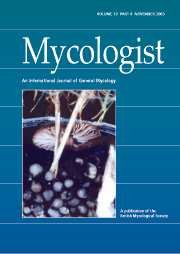No CrossRef data available.
Article contents
Teaching Techniques for Mycology: 17. The Phototropic response of Phycomyces blakesleeanus
Published online by Cambridge University Press: 09 May 2002
Abstract
Phycomyces blakesleeanus is a heterothallic zygomycete, one of three species of Phycomyces, the only genus of the family Phycomycetaceae in the order Mucorales (von Arx, 1983). A well-known feature of the genus is the production of very long black sporangiophores which have a greenish metallic sheen. These are often 10 cm and may be up to 50 cm long, and are strongly phototropic. Although P. blakesleeanus is the most frequently studied species in the laboratory, it is the closely related species P. nitens (Agardh) Fr. which seems to be commonly recorded in Britain as occurring on dung, especially the droppings of rats and mice (Ingold, 1965), and other organic refuse.
- Type
- Original Article
- Information
- Copyright
- © 2002 Cambridge University Press




